|
The Voice of Reason?
For the past couple of years, I have
been dabbling here and there in various forms of
racing, with admittedly mixed results. There
have been many highs and lows, and the only common
denominator was that regardless of how things turned
out, a lot of money changed hands!
I've also
picked up a few hobbies and additional interests
along the way. As a child I especially enjoyed
playing with model trains and cars. In
particular, I admired those elaborate room filling
train setups with multiple tracks and life like
scenery. When I came across 1/32 scale
slot car racing, it all just came together - so I
spent a few hours here and there in the off season
putting together my own racetrack, which I proudly
dubbed "CIR - Carolina International Raceway".
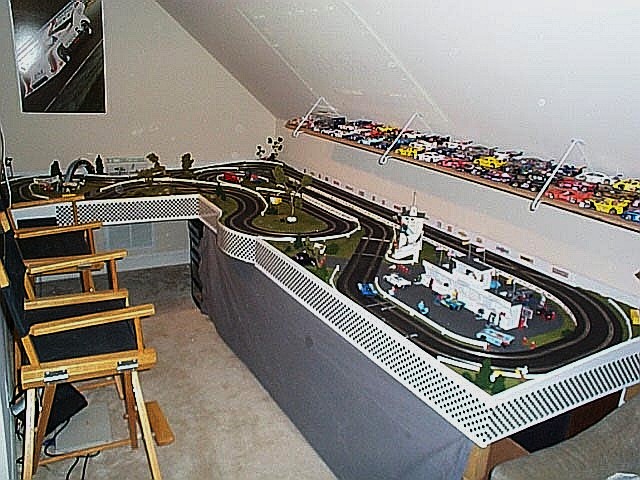
I especially enjoy collecting replicas of
real-life race cars, like this one below - an M3 GTR
that ran at Daytona in 2002.
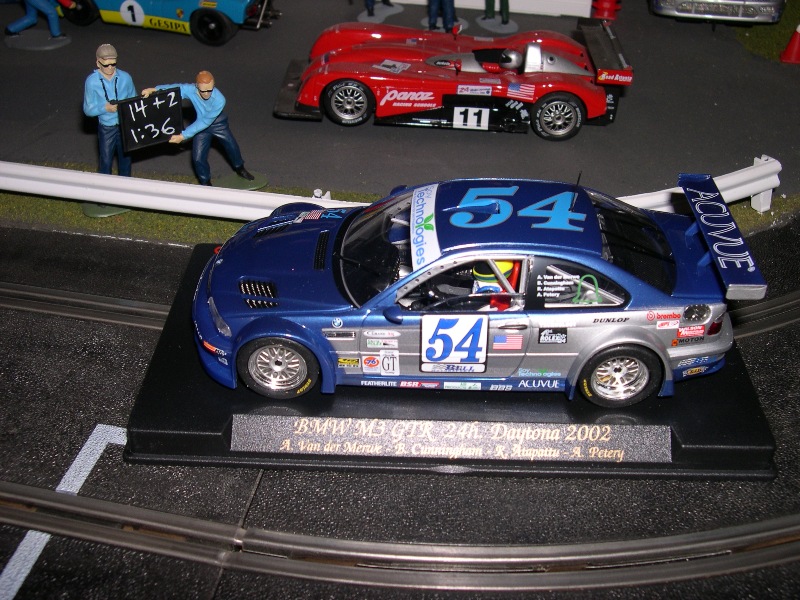
So while I'm playing around with slot cars
between racing seasons, this guy named Danny Alvis
is off collecting the real thing (look familiar?).
After it had been raced professionally in the ROLEX
series for a year or
so, Danny bought this M3 GTR, and raced it himself
in the Grand AM GT series. This is
BMW GTR chassis #001, stuffed with a big honkin' V8,
and built into a full blown race car by Bell
Motorsports.
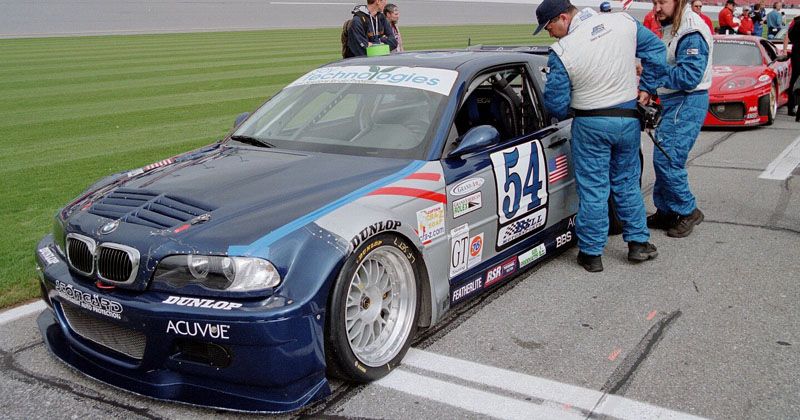
So what does this have to do with anything?
Well I'm getting to that. Early in 2005 I was instructing at VIR for a BMWCCA drivers
school. One of Danny Alvis' sons, Brian, was riding
as a
passenger in another instructor's car when I blew by
in
my ex-Speed World Challenge BMW Touring car.
Brian thought, "I've got to get a ride in that".
Later that day Brian and Chris (his older brother)
were lined up by my car to mooch some rides.
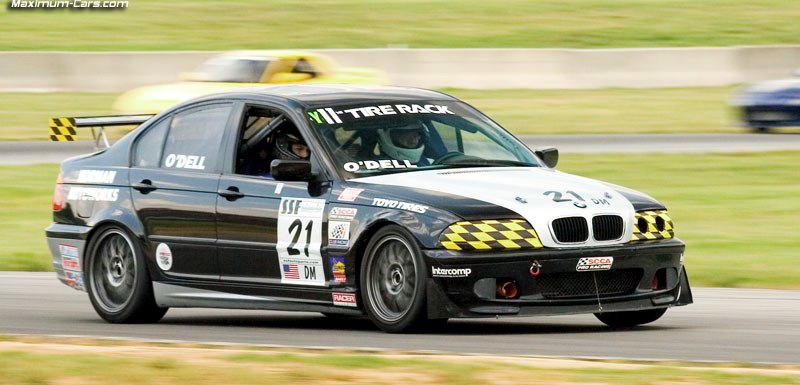
Both Brian and
Chris had done quite a bit of riding on track with
their father Danny. So after their ride in my
car, Brian and Chris told Danny that maybe this
O'Dell schmoe was someone he might want to talk to.
It seems Danny was looking for a co-driver so he
could run Grand Am again (in Grand Am, 2 drivers
share a car), so Danny
came by and introduced himself. I'm
thinking yeah, sure, but I'm not getting my hopes
up. There are a lot of folks out there that
talk about racing in the big time (or at least
"big-ger" time), but very few can pull off, so I'm
somewhat skeptical that anything will come of it.
Many months pass, and I end up running into Danny
again at another track event. In the
meanwhile, Danny has been talking with a
brilliant race car builder out of Florida, Donald
"Doc" Holness, of HBAR racing (Holness
Brothers Advanced Racing). He and Danny have
been scheming about building a new Mazda RX-8 to run in
the Street Tuner (ST) class of the Grand Am Cup.
Doc built a few cars last year for another Grand Am
team, and Danny immediately recognized how talented
Doc was. Danny starts working on me
again to run Grand Am Cup, as a co-driver.
These Grand Am Cup races are about 250 miles long,
which makes them endurance races. At the
mid-point of the race, you switch drivers - so every
car has 2 drivers. And Danny wants
somebody that could (maybe) keep up with him on
track, so to speak. He's a pretty darn fast driver behind
the wheel.
I was still on the fence regarding this Grand Am
Cup series - it costs a whole lot of money to field
a car, but the good thing is you can win some of
that money back. Nonetheless, to run a whole
series of 10 races requires a serious financial
outlay. Danny continues to work on me,
wearing me down. He invites me to co-drive as
a third driver in a 13 hour SCCA endurance race at
VIR - minimal money to race, tons of track time.
I thought it would be a good way to see if we could
get along together under racing conditions, so I
took him up on it. The car was a little yellow
Volkswagen Jetta, and I must admit, even though it
wasn't the fastest thing in the world, it was very
competitive in its class.
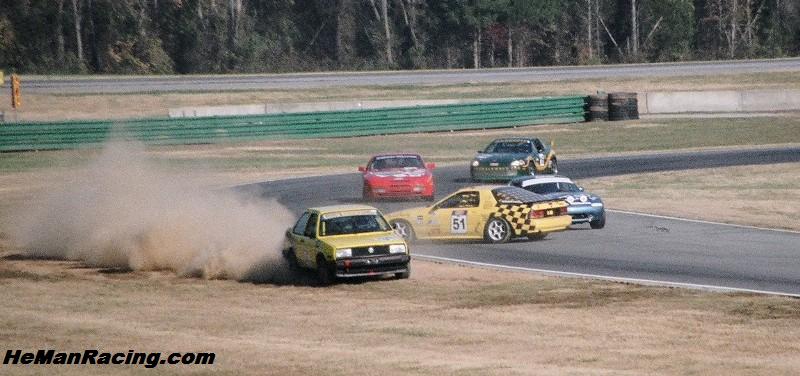
Here is "old
yellar" in turn 3 at VIR - well not exactly "in" the
turn, as we had to avoid an RX-7 that had spun in
front of us. The endurance race turned out to be the most
fun I have had racing in a long time. The car was built and fielded by
Jon Lewis, owner of German Speed Merchants out of
Wilmington, NC, and his crew was
just fantastic. All I had to do was show up
and drive - I didn't have to spend weeks prepping
the car, hauling it around, fixing it when it
breaks. Whenever there was a problem
with the car, I just got out of the way, and the GSM
mechanics literally swarmed over the car, fixing it
in a fraction of the time that I could. They
knew every single nut and bolt on that car - it was
amazing to watch! I'm now convinced that
"arrive and drive" is definitely the way to go.
So Danny works out the details with Doc on
running the RX-8 for the 2006 Grand Am Cup.
Danny's a deal-making kind of guy, so I basically
get out of the way and leave all the negotiating up
to him. At some point Doc buys a new
Mazda RX-8 and starts stripping it down to turn it
into a racecar, and Danny and I agree to drive it in
the Grand Am Cup. Doc will build the car, and
arrange to haul it around with a pit crew, spare
parts etc. The 10 races of the Grand Am Cup
are all across the USA and Canada, so that will be
no small task.
Let me tell you a few things about Danny.
He spent 20 years as an Army Ranger in Special
Forces, going to hotspots around the globe,
parachuting in, kicking in doors and taking out bad
guys. Now he is a financial planner / wizard
that puts together real estate deals, helps folks
with estate planning, and even has his own
syndicated radio show ("Its Your Money", Saturday
mornings at 9:00am EST). He's kind of a
mini-Donald Trump, without the nice hair.
Click this link for
info on Danny's show
About this time I learn that Danny has a private
plane (I should have known this based on his other
"qualities"), and his plan is to fly to the
races in it.

This plane can land on ground OR water. It
has a boat-like hull, and the wingtips are actually
integrated pontoons. Its called a "Seawind
3000 Experimental", and looks like something James
Bond would fly. Between you and me, I'm not
partial to planes with the word "Experimental" in
the name. This should tell you
everything you need to know about Danny. The other day, referring to our
"partnership", he said, "I'm the risk taker, and
your the smart guy". I agree with the first
part, but if I'm the smart guy on this team, we're
going to be a few bricks short of a full load.
I think what Danny meant is that I'm supposed to be
the occasional "voice of reason" that keeps him from
going overboard and getting into too much trouble.
So far its not working, as you'll see...
Danny is itching
to fly his plane again, so he comes up with some
cockamamie reason to get behind the controls.
"We should fly down to Florida to see Doc and get fitted for the racecar before the
first practice," he tells me over the phone. This
will be quite a trip, since we both live in North
Carolina.
"Can't we just get fitted during the practice
sessions at
Daytona?" is my response. "Nah, we should go
down ahead of time. We can fly down and back
the same day," he reasons. Getting
fitted for the car basically involves permanently
mounting the seat so that both of us can reach the
controls comfortably. The seat has to be bolted solidly to
the floor for safety. Fortunately, although
Danny is taller than me, we both have a similar leg
inseam, so we should be able to find a position that
both of us can live with.
Now I've never flown in a small plane before, so
this seems kind of exciting to me. Sounds like
a good way to kickoff our upcoming adventure.
Danny agrees to fly into tiny Louisburg / Franklin
County airport to
pick me up. Then we will fly down to Miami, see
Doc and the car, and turn around and fly back.
The plane cruises at about 175mph, and I do some
quick math. Uh, Miami is 800 miles or so,
hmmm. "Gee Danny, maybe we should fly down one
day, and come back the next morning? After
all, I don't think we should be rushed," say I,
the voice of reason. "No, we can make it down and back
the same day," Danny assures me.
So bright and early the day after Christmas, I'm
waiting at dawn on the tarmac for Danny to land and
pick me up. Its just me and the airport mascot
dog, Bump, who comes running up out of the darkness,
greeting me excitedly with some rather loud barking.
It was supposed to open at 7:00am, but I'm the only
one there. I think they weren't planning on
much traffic the morning after Christmas. The
Louisburg / Franklin County airport is SMALL.
It has 1 runway, no control tower - just an
administrative building and a bunch of hangars.
Its mainly for small private aircraft, and is
actually pretty nice as far as that goes.
Being the "voice of reason," I brought an extra pair
of clothes, just in case we need to stay overnight.
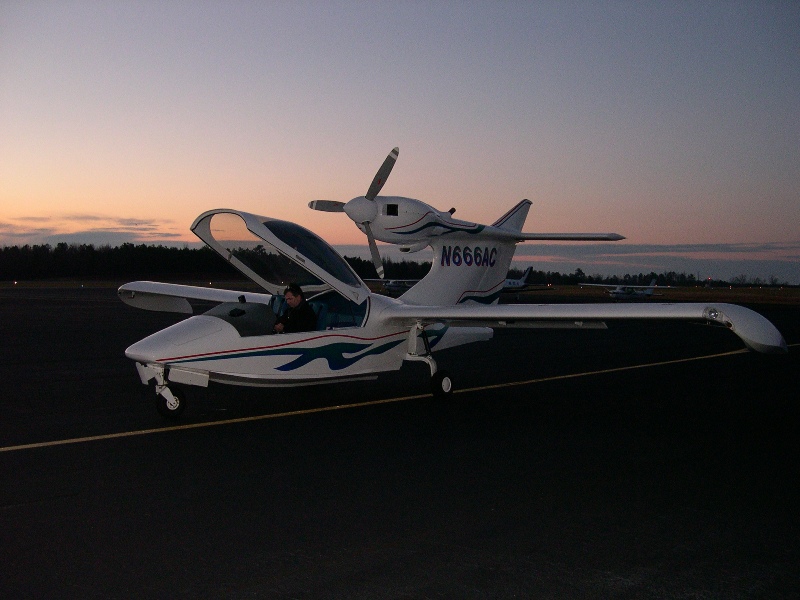
Danny's plane
swoops in for a landing and taxis up and I get my first look
at the plane. Nice landing - this guy can fly. Pretty cool
plane. Unfortunately
there is literally no one else at the airport, so
Danny can't get more fuel like he hoped. So
we'll need to make another pit stop on the way down
to Miami to top off the tanks. No big deal
though, as his tanks are still over 1/2 full.
As I find out, there are literally hundreds of small
airports along the way. You don't notice them
from the ground, but from the air, you realize they
are all over the place. Once airborne, it
seemed like we were never out of site of an airport,
which was comforting.
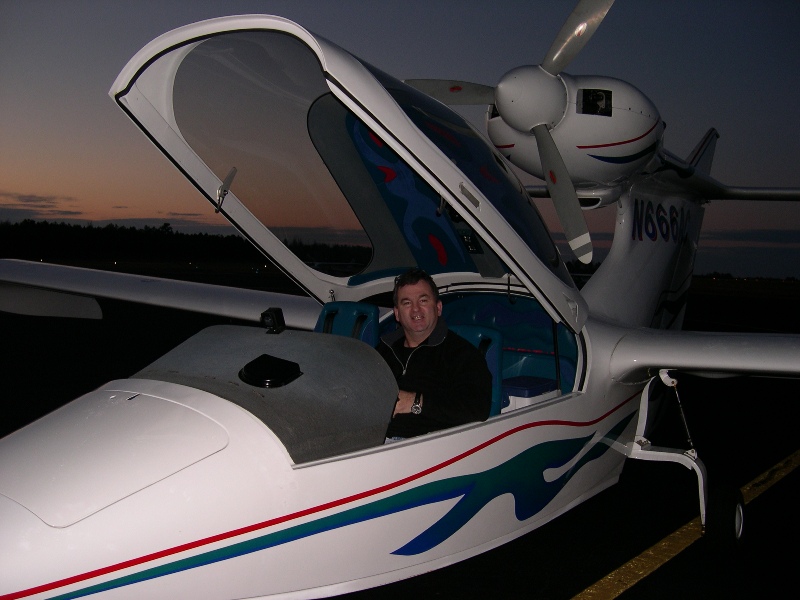
Say "Cheez!" I climb on board, and we taxi to the runway.
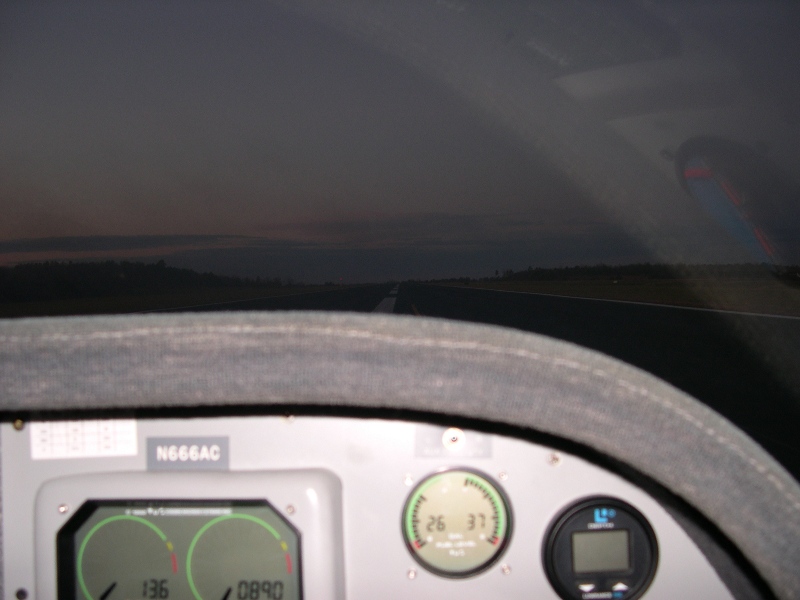
Here you see us idling at the end of the runway, the
sun still not quite over the horizon.
Notice the call sign on the dash of the plane -
N666AC, "November Triple 6 Alpha Charlie". It
was given that by the previous owner of the plane,
an ex-airline pilot whose initials where "AC".
Danny is not fond of it for obvious reasons, and has
put in a request to have it changed.
Racers are, after all, a somewhat superstitious lot.
We take off, and the first thing I notice is how
many darn instruments there are.
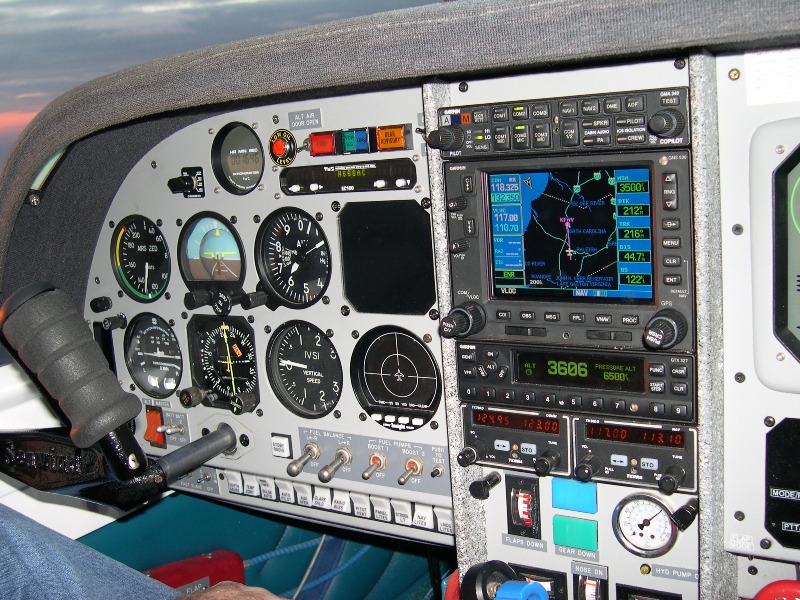
Pilots side, above, and co-pilot, below.
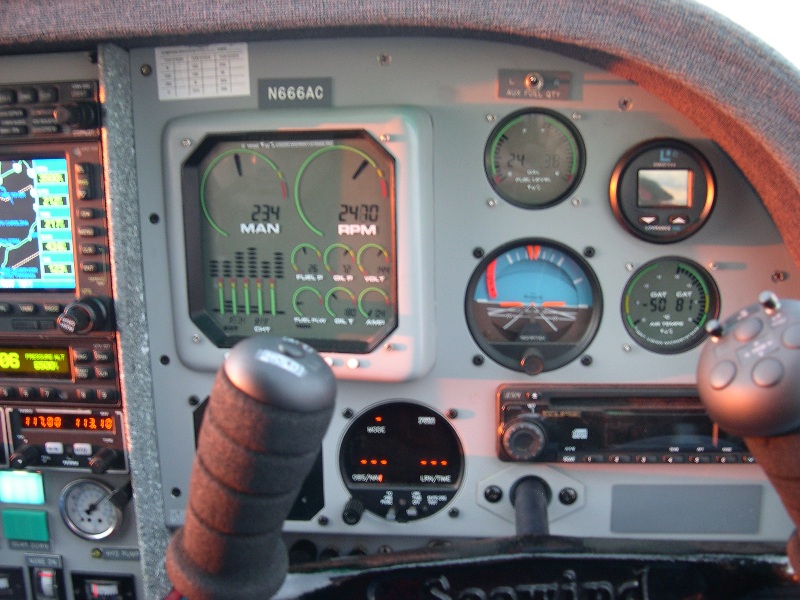
We start our cruise on down to Miami as the sun
comes up, and Danny decides that Fayetteville
regional airport is on the way, and is a good place
to top off the fuel tanks.
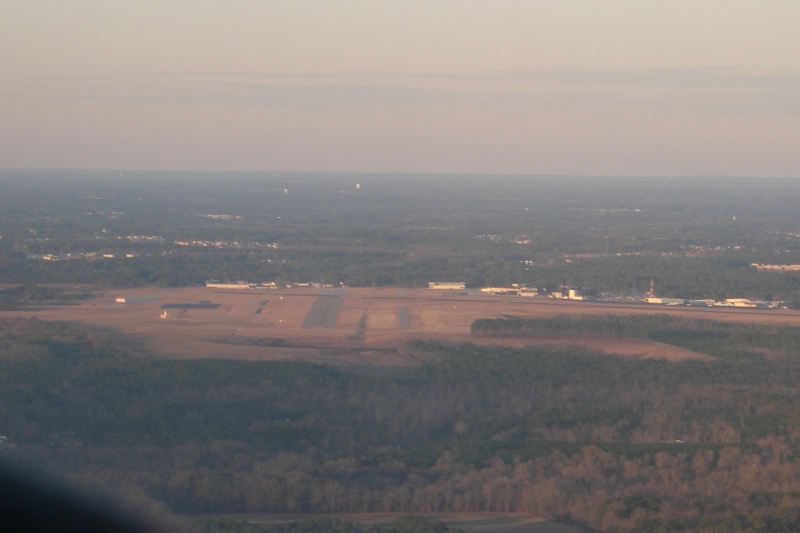
Lining up with runway 27 at Fayetteville.
The 27 numbering of the runway indicates that the
runway is to be approached by heading 270 degrees on
the compass (due west).
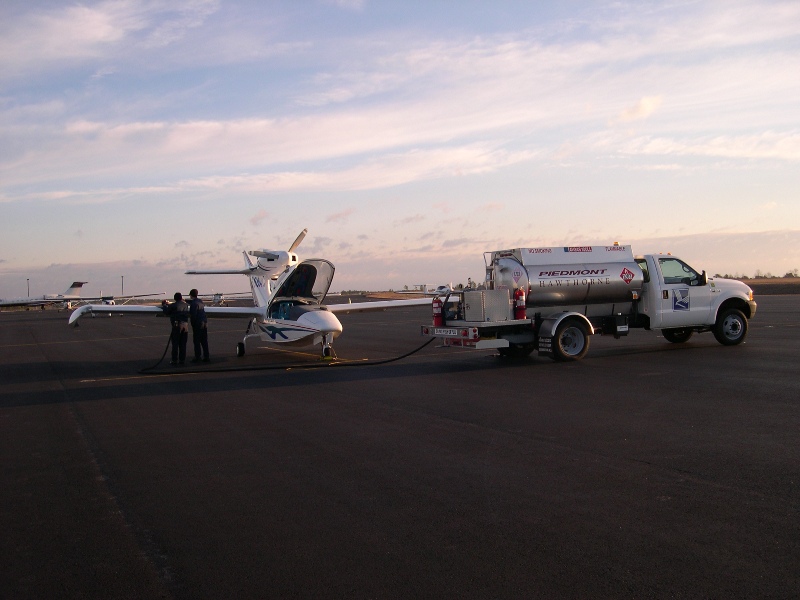
Safely down and fueling up. The plane has 4
fuel tanks - an inner and an outer tank on each
wing. The inner tanks are 38 gallons each, and
the outer tanks are 18 gallons each - for a total of
112 gallons. The plane uses about 17-21
gallons per hour, so you can safely fly 4-5+ hours
before refueling. One caveat though is that
the fuel for the engine is ONLY drawn from the inner
tanks. So after you have run for a couple of
hours, you need to start up the electric pumps to
refill the 38 gallon inner tanks, by pumping the
fuel from the two 18 gallon outer tanks.
There is also another set of electric pumps which
can pump fuel from one wing to another
(left-to-right or right-to-left), just in case the
fuel isn't being evenly drawn from the left side and
right side the inner tanks. So having a
working fuel gauge is a good idea, because it tells
you not only how much total fuel you have, but how
it is distributed in the tanks. Which
can be important, I would think.
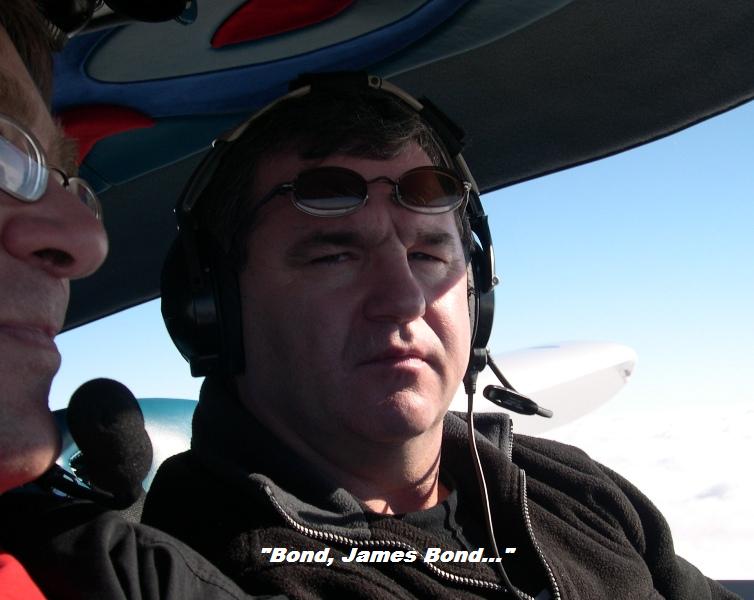
Which is why Danny is unconcerned when we take
off from Fayetteville, and the fuel gauge goes
immediately on the fritz. After all we have a
full fuel load, and only a 3 hour flight to Miami.
Plenty of reserve. But all the while I'm
thinking, "but how do you know for sure you have
enough fuel, in the correct tank?". I seem to
recall from some show on the National Geographic
Channel ("Airline Disasters" or something like
that), about a big ol' airliner that fell out of the
sky because it had a hole in one of the wing fuel
tanks. For some reason the gauges weren't
working right, and they end up pumping fuel from the
other "good" tank to the one with the hole in it,
and they ran out of gas. But I keep my fears
to myself, mainly because I can glance out the
window, and I don't see any holes in the wings.
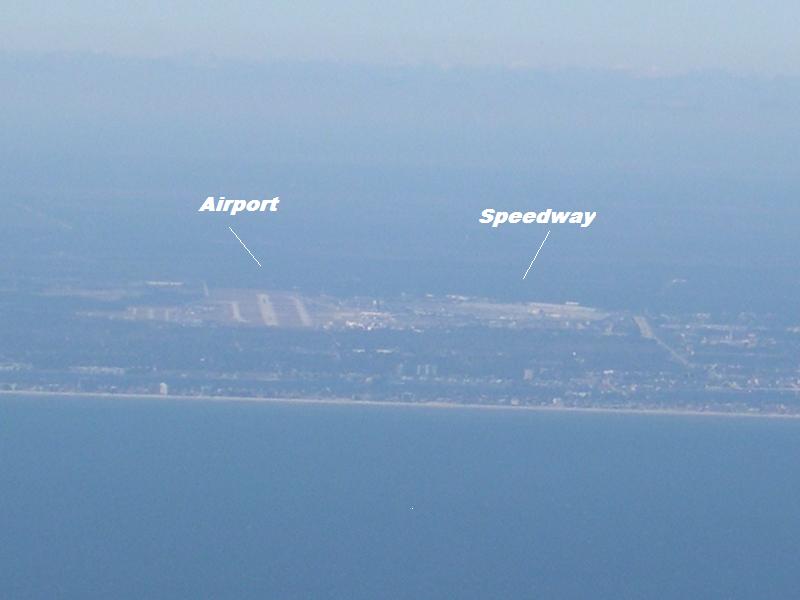
This is where we will be later next week,
practicing with the newly finished car - Daytona
airport to the left, and Daytona International
Speedway just to the right of it. Racetracks
make a lot of noise, so why not put them near the
airport, which is already making a racket? Or maybe it was
the other way around, as I don't know which came
first.
A little after noon, we land at Okalackaduca
Airport (or something like that - I didn't write it
down), which is in northern Miami, and appears to be
an abandoned army airfield from WWII.
Dilapidated DC3 hulks, missing parts of tails and
wings, are littered around the periphery. But
this airport is still being used for general
aviation, although you wouldn't know it by the
condition of the numerous large metal buildings,
showing as much rust as paint. Its much
easier if you are a private pilot to land your plane
at these smaller, less used airports. You
don't have to compete for air and runway space with
the big jets at the major airports. As long as
they have a good runway, a fuel truck and a
bathroom, they are pretty convenient. Plus you
can usually find a small airport closer to where you
actually want to go, because as I am learning, they
are literally EVERYWHERE. These airports are
the equivalent of an Exxon with a
convenience store that you find off the interstate.
Doc picks us up at the airport with his lovely
girlfriend Tamara, and we head over to his shop.
Inside the shop are 2-3 RX-8's in various states of
building and rebuilding, and an RX-7 ITS car with a
tarp half on it. All the cars are red in
color, which I guess is Doc's trademark.
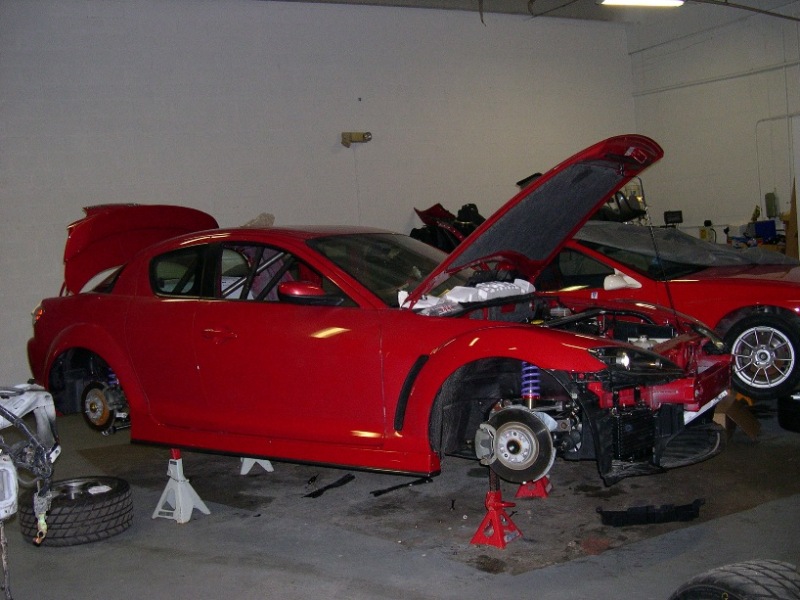
Here is "our" car, almost finished. Doc
strips them down the bare minimum parts, then puts
them back together with special racing components.
Kind of a shame to do this to a brand new car, but
that is what it takes. By starting with a new
car, we should get maximum reliability.
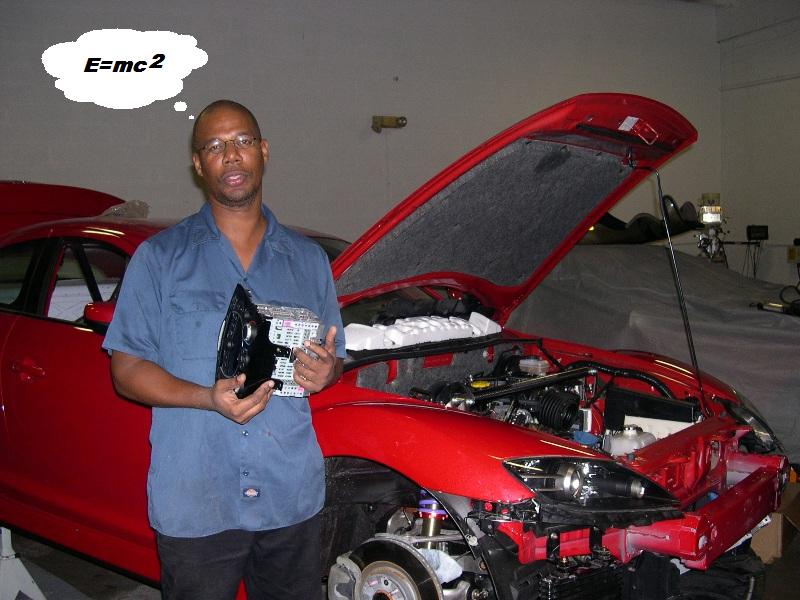
This is Doc, holding up the radio he took out of
the RX-8. Doc is practically a rocket
scientist, as you figure out pretty quickly after
you first meet him. He used to do some kind of
hush-hush Department of Defense type work, for an
aircraft company. He says it had to do with
"quantum based electronics", but that is as much as
he can or will say. He found racing to be a
bit more exciting, so now he builds race cars full
time.
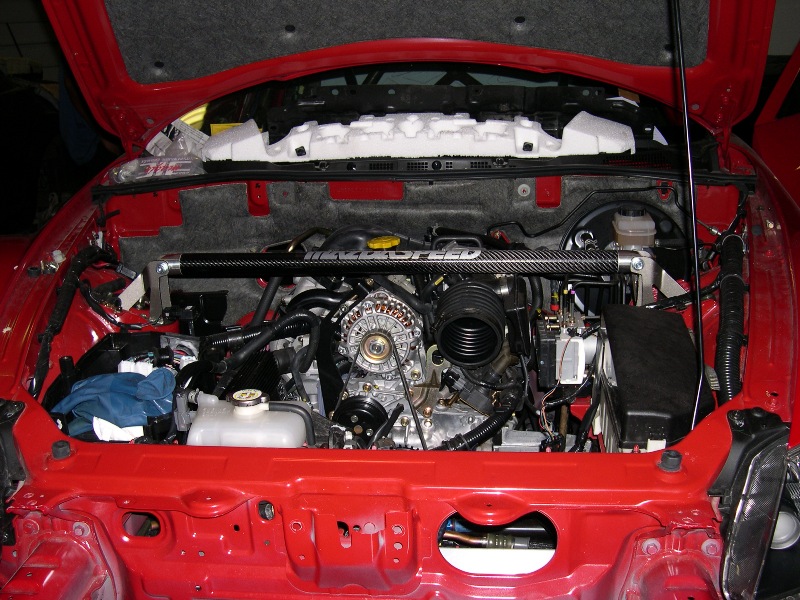
Our engine bay - the motor is stock, per the
rules, but it has some fancy electronics that I
can't talk about that will give us "a bit more power
than stock". How much more?
I can't say - some things are secret! Just
remember, Doc is an electronics wizard...
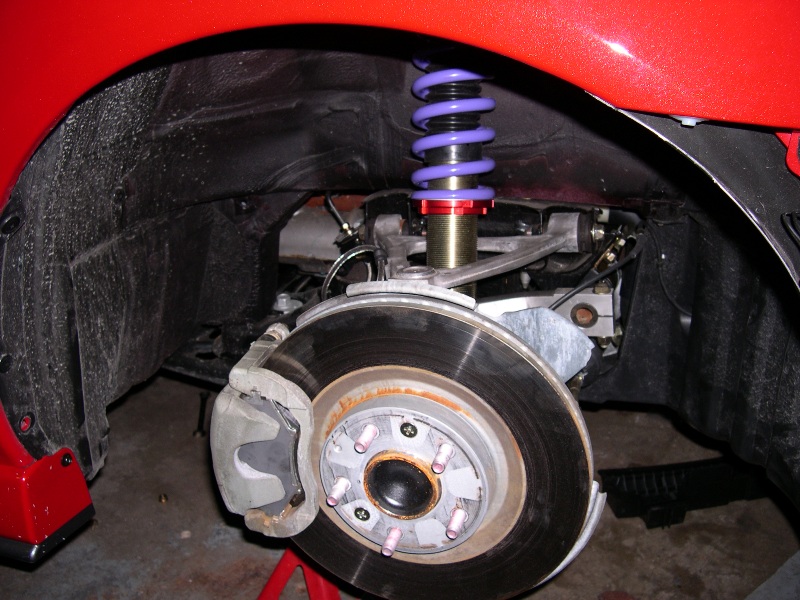
Front suspension, showing off the racing
coil-over shocks. Pretty-in-purple springs, go
well with the car, don't you think?
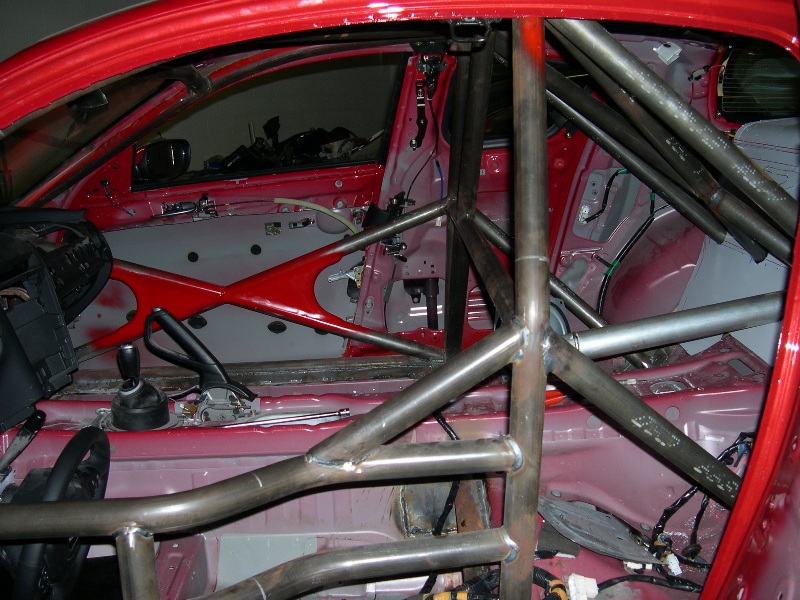
Drivers compartment, showing off the cage.
Doc will repaint the interior to be a nice uniform
color when he is done.
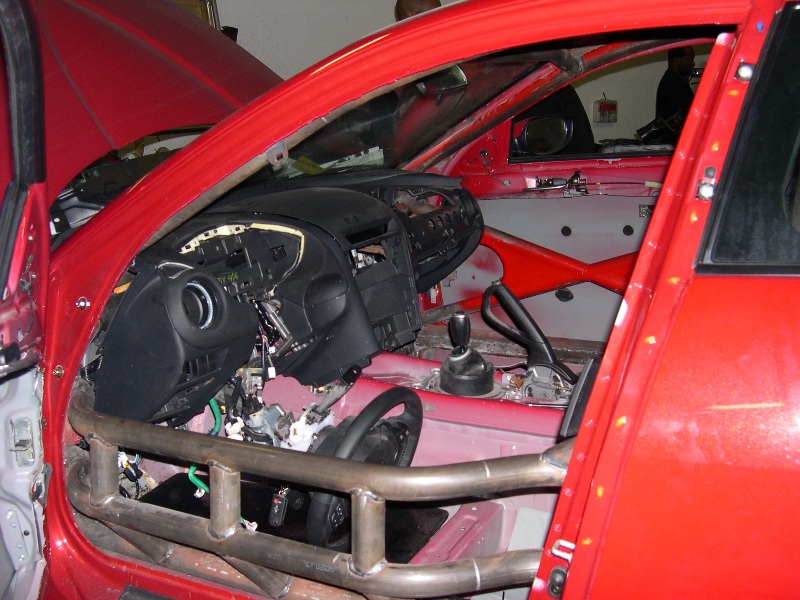
He's ripping the dash electronics out, replacing
them with a sophisticated racing specific instrument panel.
Doc worked with with some European company so that
it would integrate with the RX-8's engine management
system. There is no seat mounted yet, so it doesn't look
like we will get fitted for the car today. Doc
says we can do that before practice next week.
Hey wait a second - I, the "voice of reason," said
exactly that to Danny a few
days ago. Why did we fly down here again?
This is when I realize Danny was just looking for an
excuse to fly his airplane and that I've been
hoodwinked!!! That's ok, I really wanted to
see Doc and the car anyway.
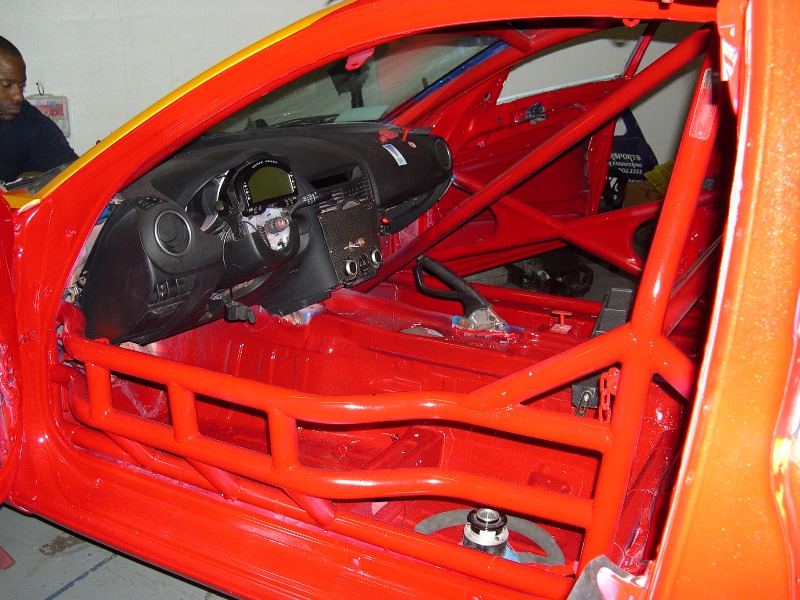
This is a finished car (not ours), which Doc
built last year. Ours should look like this
when he is done.
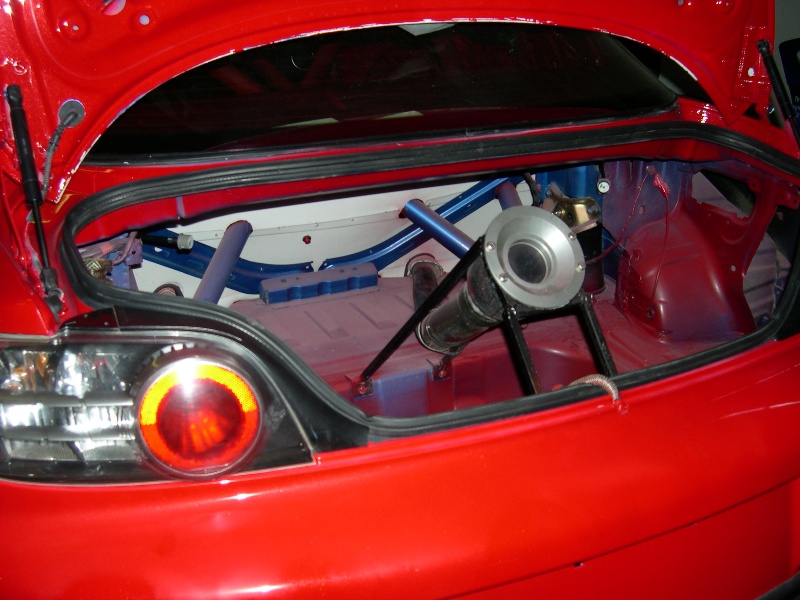
Trunk mounted fueling setup (on the finished
car), with a dry break fitting. This special
setup will allow us to refuel very quickly due to
the high flow rate, which is very important to keep
the pitstop short.
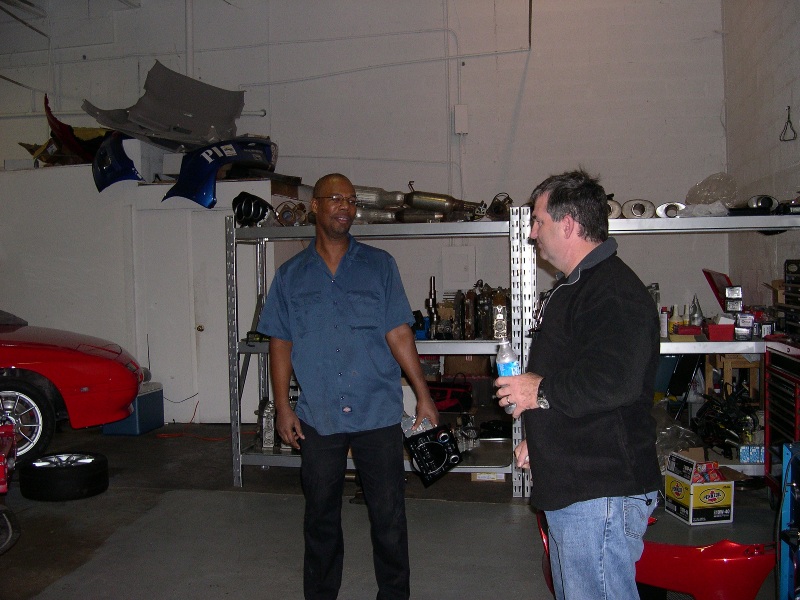
Doc explaining to Danny about how he has built a
kick-a@@ race car, and you better be up to driving
it, buster! No really, Doc is explaining
how he worked with some European company to custom
code an integrated dash for the racecar, using the
XYZ software protocol, so that it could interface to
the.... All Danny and I hear is "blah, blah,
blah Racecar blah, blah, blah".
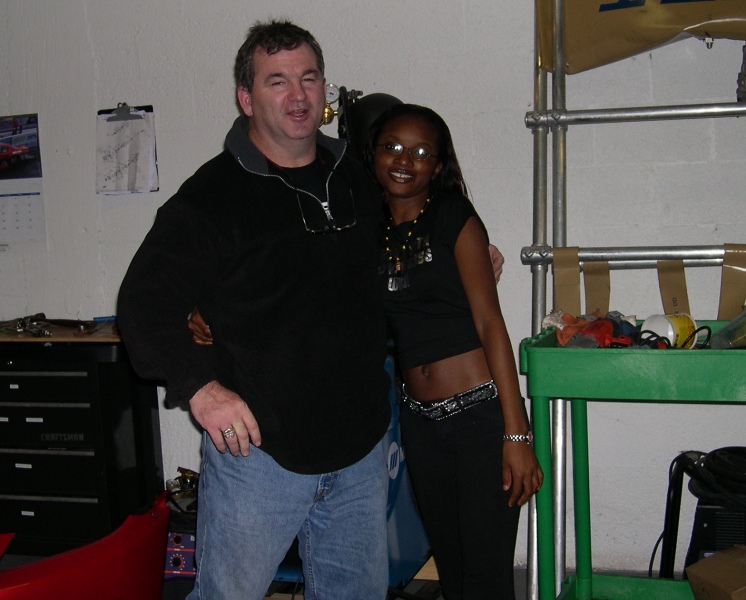
Doc's
girlfriend, Tamara, and Danny. I conned Danny
into posing for this shot, so I could bank this photo for
later, maybe to use as, how shall we say, "leverage". But in
retrospect, its much too tame for that, and besides, its the
only photo I have that includes Tamara.
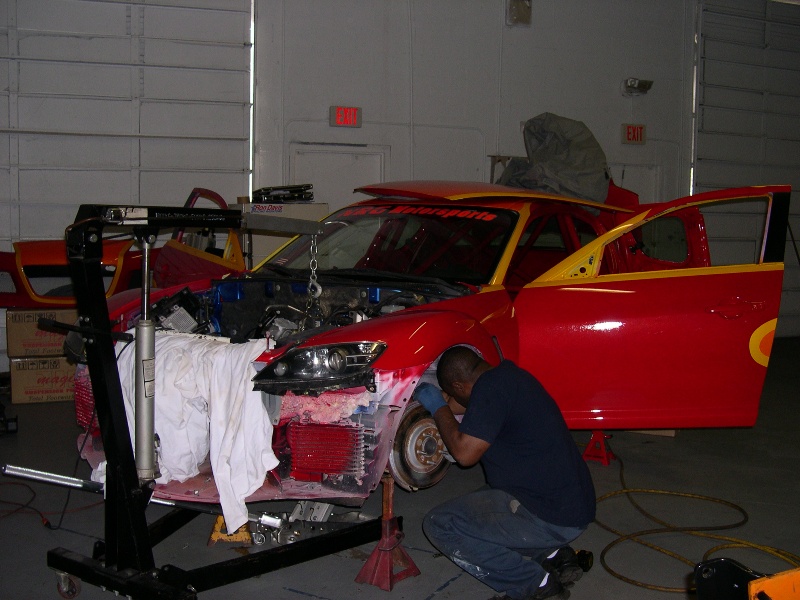 One One
Here is one of the
Holness Brothers built RX-8's that ran in
last year's Grand Am cup series, getting fitted with
a fresh motor.
Doc and Tamara take Danny and I out to lunch at a
local Jamaican restaurant, which I really enjoyed.
We had chicken with a flavorful brown sauce, rice
with "peas" (which looked an awful lot like pinto
beans to me), and drank fresh Jamaican coconut
water, which is a bit of a treat. Then it was
off to the airport.
Prior to leaving, Danny checked the fuel level
using a dipstick which he manually lowered into each
of the 4 fuel tanks. It seemed like the engine
was drawing better from one side of the plane's
tanks than the other, because he found the remaining
fuel wasn't so evenly distributed. This
isn't completely abnormal, but without a working
fuel gauge, you wouldn't know this while you were
flying, so you couldn't use the pumps to move the
fuel around to balance it out. And since we
couldn't verify if the pumps were actually pumping
the fuel around without the fuel gauge, it meant we
didn't want to risk flying the plane to its maximum
range. So on the return we would plan to stop
sooner than normal, just to top off the tanks.
Before we left, the ground crew refilled our fuel
tanks, then at 3:00pm we lifted off.
We got no more than 1000 feet into the air, when
some of the instruments on my side of the plane went
blank! All of these instruments are
controlled by a single computer (the same computer
that controlled the fuel gauge, it turns out), so
Danny figured that computer was having problems.
So not only did we not have a fuel gauge, but we
didn't have any of the engine monitoring instruments
as well. So we couldn't see engine speed,
engine temperature, oil pressure, oil temperature,
fuel pressure, or voltage and current for the
electrical system. The last part (voltage and
current) turned out to be a bit of a problem -
more on that later.
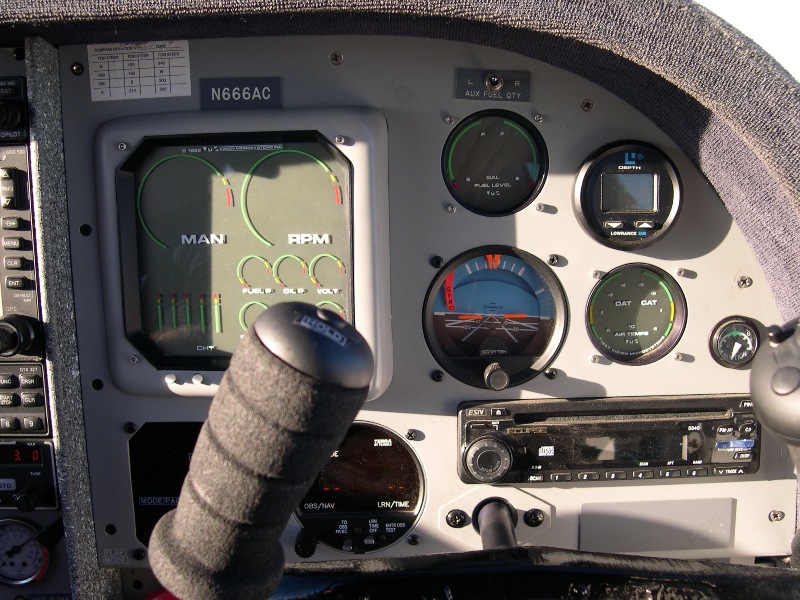
So how fast is
the engine turning? What is the oil pressure?
We don't know! Now admittedly 100 years ago in the early days of
flight, bi-planes didn't have any of these things,
and still flew around pretty successfully (for the
most part). Nonetheless, I'm thinking
why don't we just turn around and land this thing,
and as "the voice of reason," I say as much. Danny says, "No we'll be
ok." All the critical systems were still
working, like the radios, the navigation system, and
all the mechanical (non-electrical) gauges like the
altimeter, etc. Danny said we would just take
it easy on the plane, and run the fuel mixture a
little rich to make sure we don't overheat anything.
I'm thinking, you know, its not the first mistake
that kills you when you fly a plane. Its the
second one you don't know about BECAUSE of the first
mistake. Like the engine oil pressure starts
to drop, and because you don't have any
instrumentation to see it... Or something like
that.
But you know what, I decide I'm not going to be a
wuss, and I'm not going to worry about it (must be
the Jamaican food I ate). Danny's made up his mind,
and otherwise the plane is running well so just try
to enjoy the trip. The visibility is
fantastic, and quite frankly it was a beautiful day
to fly.
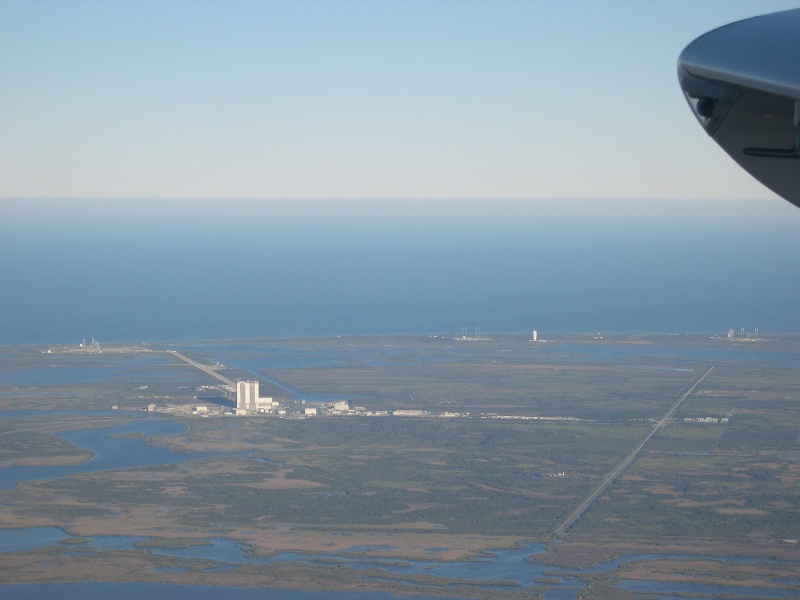
This is the Kennedy Space Center. The
big building in the center is the oversized hanger
building for the launch "vehicles". Out
towards the coast, you can see several gantries for
the different launching pads they use.
After passing by Cape Canaveral, we started heading
out over the water, towards Myrtle Beach, where
Danny planned to stop for fuel. If we had
working gauges we could have made it all the way
home on one tank, but Danny agreed we should stop
well short to top up for fuel, just in case.
Its more of a direct line to fly out over the ocean,
and heck, our plane can land in water if we had to.
But then, somewhere off the coast of
Jacksonville, something funny started to happen.
Our radio and Navigation system flickered off and
back on. Now they did come back on, but that
was very troubling, as it would be hard to land the
plane without a radio to contact the control tower,
and the navigation system was necessary to find the
airport. At this point Danny correctly
assessed that we had an electrical problem. He
figured the alternator crapped out, and we were
running off battery power. So he decided to
shut off one of the batteries (the plane has two),
and run only on one battery at a time. That
would keep one battery in reserve. He shut
down any electrical system that we didn't need to
fly the plane, to make sure we didn't run
out of electrical power. And he made one more
critical decision. We would stop in Savannah
instead of Myrtle Beach (much closer). He
angled the plane toward Savannah, but we still had
about 45 minutes to go. And it was after 5:00,
so the sun was going down.
I'm pointing out to Danny that there are
a few
smaller airports between here and Savannah that we
could stop at, but Danny wants to make it to
Savannah, because there will be facilities there for
fixing the plane. Somewhere along the way,
Danny has to switch to the remaining battery.
Darkness descends as we approach Savannah.
Danny is having me hold a flashlight on the
instrument panel, so he won't have to use precious
electricity on the instrument panel lights. Danny
contacts the tower, and we have to angle around to
line up with the runway, so it takes awhile.
Finally, its now completely dark, but we are lined
up with the runway, and we are cleared to land.
All you can see in front of us is utter blackness -
and the runway a mile ahead, lined on both sides with bright red
lights. About 1/2 mile off the end of the
runway, our remaining battery starts to give out.
As we approach, we lose the radios and the
navigation system. Fortunately we've already
gotten clearance to land. And the engine is
self sufficient - as Danny explained, the engine
gets its electrical power off of mechanically driven
magnetos, so it will run no matter what happens to
the electrical system. Danny lands the
plane in the darkness, and as we taxi, he manages to
switch the radio back on briefly, getting directions
for where to park. Phew!
We park the plane at Savannah Aviation, but it is
closed for the night. Danny manages to phone a mechanic, who agrees to start working on
the plane first thing in the morning. I call
and get us a room at the Days Inn, almost within
walking distance of the terminal. Right now,
"the voice of reason" is feeling pretty proud of
himself / myself for bringing an
extra set of clothes and a tooth brush.
Of course I can't resist giving Danny some grief for
not doing the same.
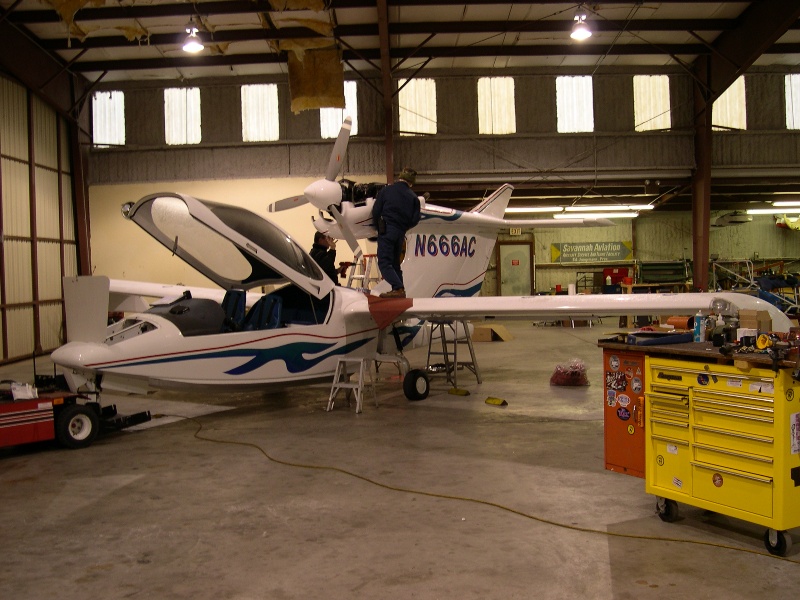
The next morning we go back over to the Savannah
Aviation terminal, where we find the mechanic has
already started to move the plane to an indoor hanger so he
can work on it. I'm needling Danny about how
fresh I feel in my clean underwear, and Danny
retorts "That's ok, I'm not wearing any!" I
guess that must have been part of Ranger training...
those guys are tough!
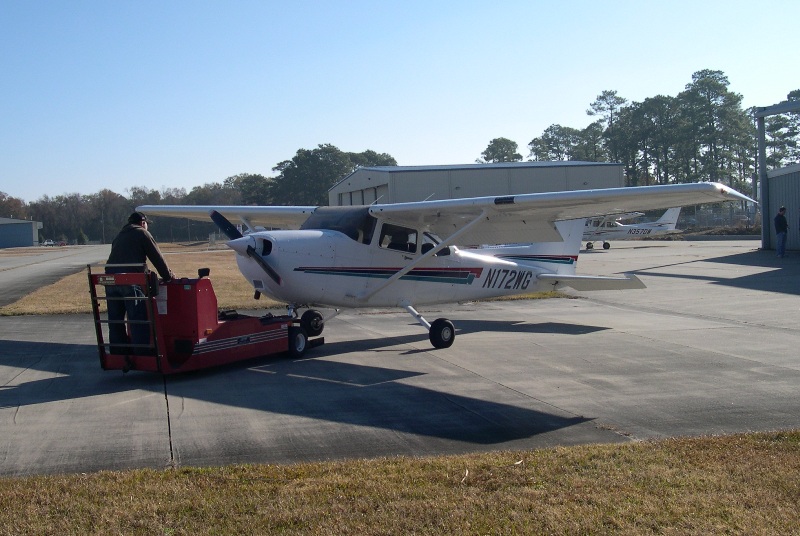
They use these little electric trucks to move the
planes around. It doesn't take much, since the
planes are so light.
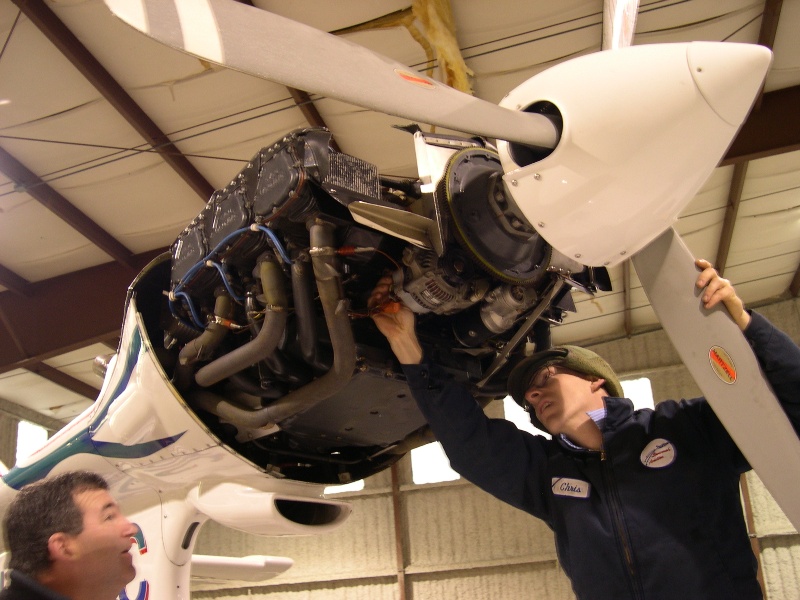
Chris, the mechanic, had never seen a Seawind
before, but that is not unusual as Danny says there
are only about 60 or so of them. But Chris
knew what to do.
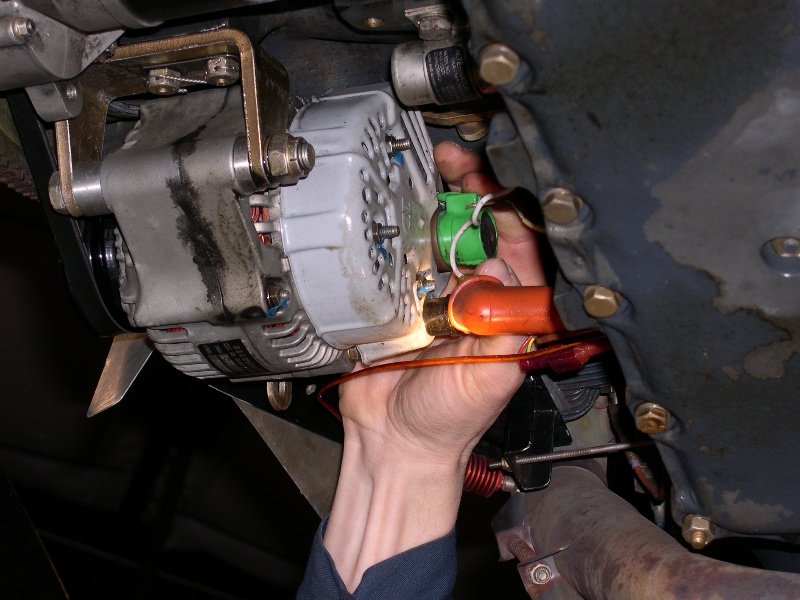
Chris found the
culprit - this green connector on the back of the
alternator was about ready to fall out.
Without a good connection, the alternator wouldn't
work, so the batteries discharged.
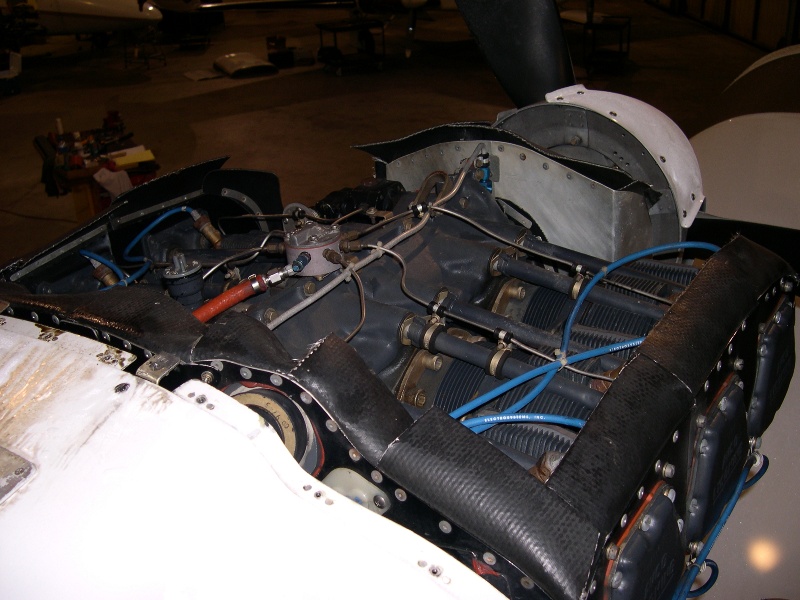
While Chris was fabricating a new connector,
Danny had me top off the oil level. Here is a
picture of the engine as seen from the top. It
is a horizontally opposed flat six, air cooled
engine, not unlike what you might see in a Porsche
911. Danny also took off the cowling on
the instrument panel, to see if he could figure out
what was wrong with the computer that controlled
those instruments we lost earlier. It seems
like even after Chris fixed the alternator, and
recharged the batteries, those pesky instruments in
front of me didn't come back on. However
everything else was working ok, and it was another
beautiful day to fly, so we decided to head for
home.
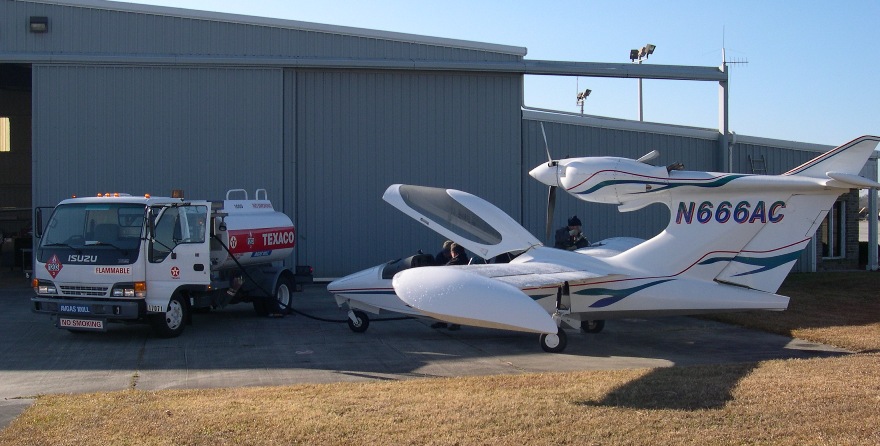
But first, we top off the fuel tanks. Then
they tried to fire up the plane and it wouldn't
start! Chris and Danny were trying all sorts
of things, but it just wouldn't go. Then I
asked Danny, "Did you turn the fuel back on?".
Danny gives an "Oh Sh@#", turns the fuel back on,
and the plane starts up. Sometimes its the
obvious...
Today's weather turns out to be even better than
yesterday, and we are in pretty good spirits. And
then, about an hour into the flight, mysteriously
all the gauges started working again! The fuel
gauge, the engine gauges, everything was back to
normal! All systems were working
beautifully. Danny is going to call the
manufacturer of the instrument computer, to try to
get an explanation.
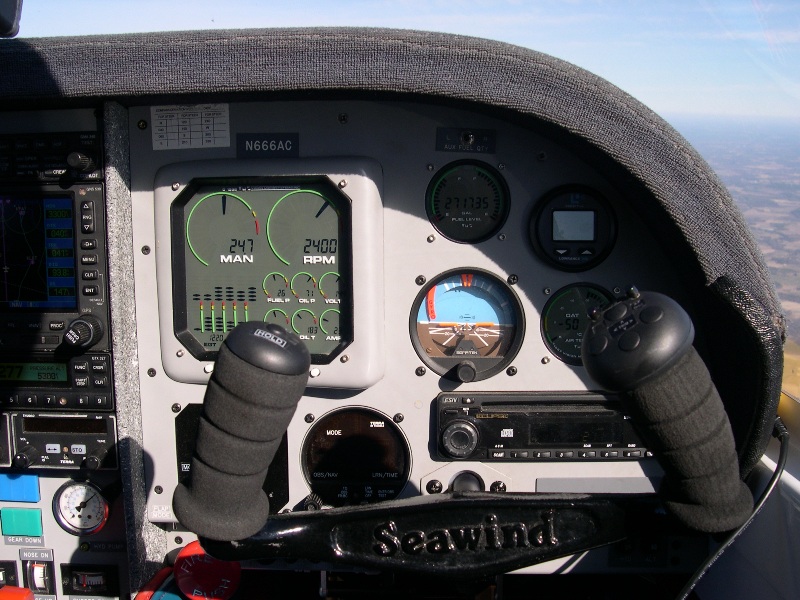
As we head back to the Louisburg / Franklin
County airport, I told Danny to fly over my house.
I called my wife on my cell phone, and told her to
go outside and look for us. Danny
dropped down to about 1000', and made a U turn right
around our house, and I could see my wife and
mother-in-law (who was in town for Christmas) waving
from the lawn below.
Danny made a textbook landing at the Franklin
County airport, despite a fairly strong crosswind.

This time the airport was open, and several of
the employees came out to gawk at the plane.
It really is an unusual plane, and no one had ever
seen one before, which was a phrase we heard a lot.
Actually, no one that we met during the entire trip
had ever seen one before. An Apache
helicopter came in for a landing while we were
there, and delayed Danny's take off while it
performed some touch and go landings.
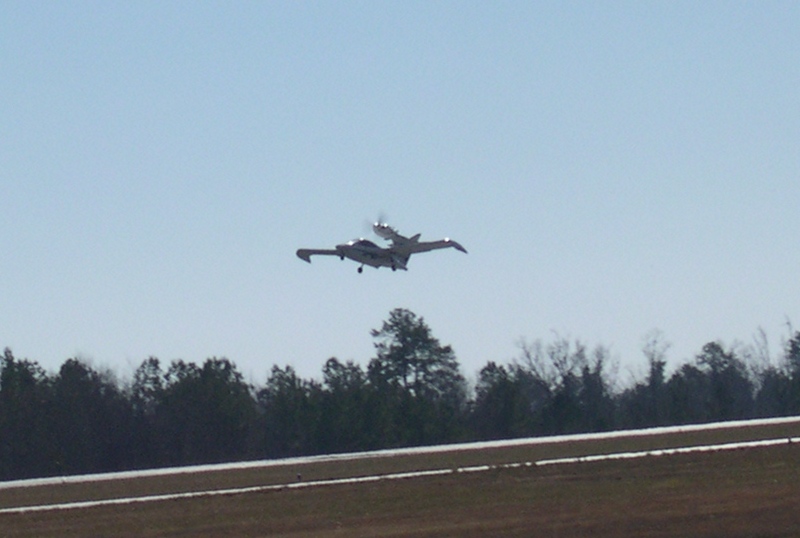
Up...
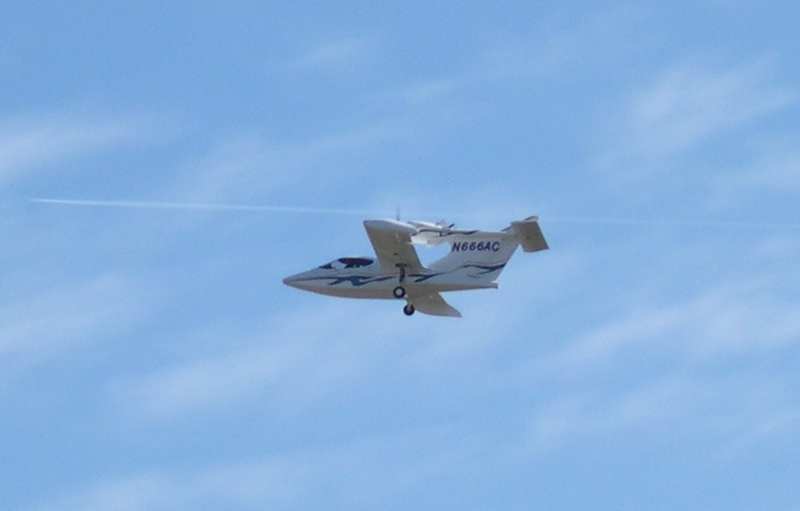
up...
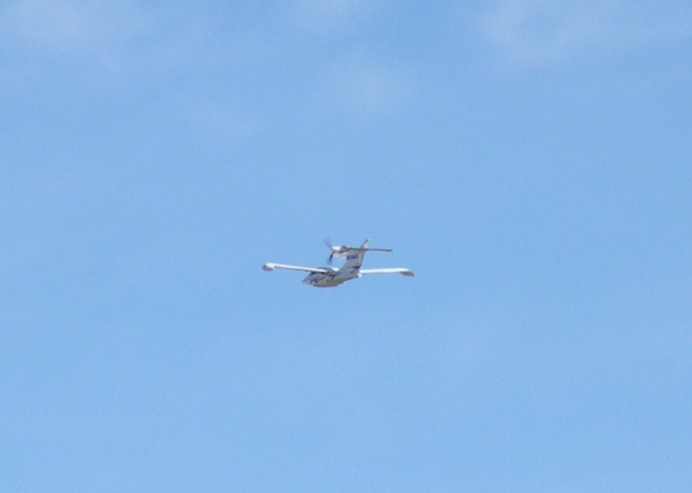
And away!
So ends the beginning... |

